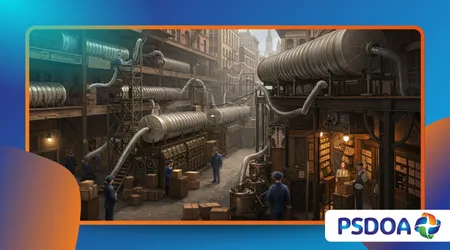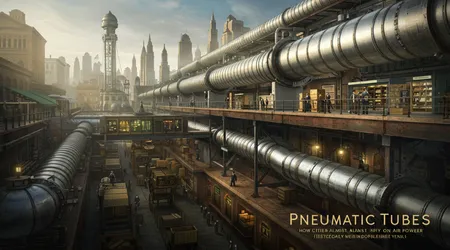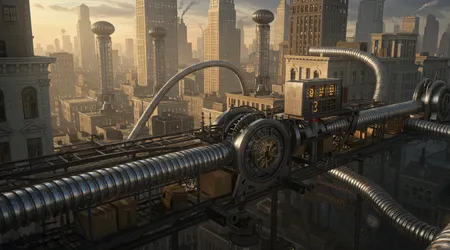Pneumatic Tubes: How Cities Almost Ran on Air Power

Pneumatic tubes once promised a revolution, zipping messages and goods through cities at breathtaking speeds.
Anúncios
Imagine a world where air pressure powered urban logistics, connecting post offices, banks, and stores with invisible highways beneath the streets.
This forgotten invention, born in the 19th century, captivated engineers and dreamers alike, offering a glimpse of a future where physical distance dissolved.
Though largely abandoned, its legacy whispers lessons about innovation, ambition, and the fleeting nature of technological triumphs.
Why did this bold idea fade, and could it inspire modern solutions? Let’s dive into the rise, fall, and enduring intrigue of a system that nearly transformed urban life.
Anúncios
The Birth of a High-Speed Dream
In the 1830s, engineers envisioned a radical solution for communication delays. Pneumatic tubes emerged, using compressed air to propel capsules through metal pipes.
Early experiments in London’s telegraph offices proved the concept, sending messages at 20 miles per hour. By 1853, the technology scaled to public use, with systems installed in major European cities.
The appeal was undeniable: instant delivery in an era of horse-drawn carts. Businesses, from newspapers to stock exchanges, embraced the speed, slashing hours off critical transactions.
Victorian society marveled at the ingenuity. Capsules, or “carriers,” could hold letters, money, or small parcels, rocketing through underground networks.
The technology symbolized progress, a mechanical pulse beneath bustling cities. Unlike telegraphs, which transmitted only words, pneumatic tubes carried tangible goods, bridging the gap between virtual and physical.
++ The Ice Houses of Ancient Persia: Natural Refrigeration Without Electricity
This tactile efficiency fueled dreams of city-wide systems, where air power rivaled steam or electricity.
The dream wasn’t flawless, though. Early tubes demanded constant maintenance, with leaks disrupting airflow. Yet, the promise of speed outweighed the challenges.
Innovators like George Medhurst, who patented designs in 1810, saw potential for passenger transport, though such ambitions remained theoretical.
The focus stayed on practical applications, laying the groundwork for a global phenomenon. Could air-powered logistics truly reshape urban life?

The Golden Age of Pneumatic Networks
By the late 19th century, pneumatic tubes became urban lifelines. New York City’s 27-mile network, launched in 1897, connected 23 post offices.
A 1908 report noted it handled 6 million letters annually, cutting delivery times from hours to minutes.
Paris, Berlin, and London followed, with tubes linking government offices and banks. The technology’s precision awed users, as capsules arrived with a satisfying “thunk.”
Department stores adopted the system for transactions. Cashiers sent payments to central offices via pneumatic tubes, streamlining sales. Hospitals used them to rush lab samples, saving lives.
Also read: Self-Cleaning Clothes: A Forgotten Innovation That Still Impresses
The versatility was staggering tubes carried everything from telegrams to jewelry. At its peak, over 50 cities worldwide boasted networks, a testament to the technology’s allure.
Yet, the golden age revealed cracks. High installation costs limited expansion, and maintenance demanded skilled labor.
Urban growth strained systems, as longer routes slowed delivery. Still, the tubes thrived where speed mattered most.
Their reliability in dense cities underscored a truth: innovation flourishes when it solves urgent problems. But could it scale to match a rapidly changing world?
The cultural impact was profound. Tubes starred in literature and film, embodying futuristic optimism. H.G. Wells referenced them in utopian visions, while early sci-fi imagined air-powered cities.
Public fascination grew, with tube stations becoming tourist attractions. The technology wasn’t just functional it was a spectacle, a mechanical ballet beneath the pavement.
Why the Tubes Fell Silent
The 20th century brought rivals that dimmed the shine of pneumatic tubes. Telephones and telegraphs offered cheaper, instant communication.
By the 1920s, automobiles and electric railways outpaced physical delivery needs. Tubes, once cutting-edge, seemed quaint against these advances. Cities like New York retired their networks by the 1950s, citing high costs.
Maintenance woes accelerated the decline. Leaks, blockages, and worn pipes plagued aging systems. A 1930s study estimated repair costs at 20% of annual budgets for major networks.
Urban sprawl made new installations impractical, as digging up streets grew costlier. The technology’s niche short-range, high-speed delivery couldn’t compete with broader solutions.
Read more: 17th Century Submarines: A Century Ahead of Their Time
Human error also played a role. Misrouted capsules caused delays, eroding trust. Unlike digital systems, tubes offered no real-time tracking.
As businesses demanded reliability, alternatives like fax machines gained traction. The tubes’ physicality, once a strength, became a liability in an increasingly virtual world. Was their obsolescence inevitable, or did society overlook their potential?
Cultural shifts sealed their fate. Post-WWII optimism favored flashy innovations jets, computers over incremental improvements to older systems.
Tubes, tied to Victorian aesthetics, felt outdated. Yet, their decline wasn’t universal. Some hospitals and banks retained them, valuing their simplicity.
The question lingered: could modern upgrades have saved them?
Modern Echoes and Niche Revivals
Today, pneumatic tubes persist in surprising places. Hospitals worldwide use them for rapid sample transport, with a 2023 study estimating 70% of large U.S. facilities rely on them.
Their immunity to digital outages makes them invaluable in critical settings. Banks, too, maintain drive-thru systems, proving the technology’s enduring utility.
Tech visionaries occasionally revisit the concept. Elon Musk’s Hyperloop, a high-speed passenger tube, echoes early pneumatic dreams.
While not identical, it shares the vision of air-driven transport. Small-scale startups experiment with tubes for last-mile delivery, aiming to reduce urban congestion. These efforts suggest the idea isn’t dead just dormant.
Sustainability adds intrigue. Tubes use minimal electricity compared to drones or trucks. A 2024 trial in Amsterdam tested pneumatic tubes for waste collection, cutting emissions by 30%.
Such applications highlight their eco-friendly potential. Could they complement modern logistics in a carbon-conscious world?
Nostalgia fuels interest, too. Museums like the Postal Museum in London display working tube systems, drawing crowds.
Collectors trade vintage capsules online, and steampunk enthusiasts celebrate the aesthetic.
The technology’s charm lies in its tangible mechanics a contrast to today’s intangible digital networks.
Lessons from a Forgotten Future
The story of pneumatic tubes offers timeless insights. First, innovation thrives on urgency but falters without adaptability. Tubes solved 19th-century problems but struggled to evolve.
Modern tech, like AI or blockchain, risks similar fates if it can’t pivot. Flexibility is the lifeblood of progress.
Second, cost often trumps vision. High maintenance and installation expenses doomed tubes, despite their efficiency. Today’s green tech, like solar grids, faces similar hurdles.
Balancing affordability with ambition remains a universal challenge. Can we learn to prioritize long-term gains over short-term costs?
Finally, nostalgia isn’t enough. While tubes inspire awe, sentimentality didn’t save them. Reviving old ideas demands practical reinvention, not just fond memories.
Think of vinyl records: their comeback succeeded because they offered unique value. Could tubes find a similar niche?
The analogy of a river fits here. Like water carving a path, pneumatic tubes followed the easiest route urgent, short-range delivery until the landscape changed.
Rivers dry up when new channels form, but their beds remain, hinting at past power. Tubes, too, linger in our imagination, ready for rediscovery.
A New Vision for Air-Powered Cities

Imagine a city where pneumatic tubes handle micro-logistics. Pharmacies could send prescriptions to homes in minutes, easing healthcare access.
Retailers might use tubes for same-day delivery, outpacing drones. A 2025 pilot in Singapore explores this, linking stores with residential hubs. Early data shows 40% faster delivery than vans.
Such systems could reduce urban clutter. Fewer delivery trucks mean less traffic and pollution. Tubes, buried underground, preserve city aesthetics.
Unlike drones, they’re silent and unobtrusive. The challenge lies in scaling modern cities demand robust infrastructure. Can engineers overcome the cost barrier?
Public perception matters, too. Tubes must shed their retro image to gain traction. Marketing them as green, high-tech solutions could help.
Picture a campaign showcasing a capsule zipping medicine to a patient, saving time and emissions. Emotional storytelling could reignite public excitement.
Governments could incentivize adoption. Subsidies for tube networks, like those for electric vehicles, might spur investment.
Urban planners could integrate them into smart cities, alongside 5G and IoT. The potential is vast, but it hinges on bold leadership and creative financing.
| Pneumatic Tube Milestones | Year | Description |
|---|---|---|
| First Patent | 1810 | George Medhurst’s design for goods transport. |
| London Telegraph System | 1853 | Public tube network for messages. |
| New York Postal Network | 1897 | 27-mile system for 6 million letters yearly. |
| Hospital Adoption Peak | 2023 | 70% of large U.S. hospitals use tubes. |
| Amsterdam Waste Trial | 2024 | 30% emission reduction via waste tubes. |
Conclusion: Breathing New Life into Old Ideas
The saga of pneumatic tubes is more than a historical footnote it’s a mirror reflecting our technological journey.
From Victorian marvel to modern relic, they embody the thrill of invention and the sting of obsolescence. Yet, their niche persistence and eco-friendly potential hint at untapped possibilities.
Could air power, reimagined, ease the burdens of urban life? The question isn’t just nostalgic it’s urgent in a world craving sustainable solutions.
Their story reminds us to cherish bold ideas, even when they falter. Innovation isn’t a straight line; it’s a cycle of dreams, failures, and rediscoveries.
As cities grapple with congestion and emissions, pneumatic tubes offer a whisper of inspiration.
Perhaps, like a capsule in a forgotten pipe, their time is poised to arrive again. Let’s not dismiss the past it might just hold the key to our future.
Frequently Asked Questions
1. Are pneumatic tubes still used today?
Yes, hospitals and banks use them for rapid transport of samples or cash. A 2023 study shows 70% of large U.S. hospitals rely on them.
2. Why did cities abandon pneumatic tube networks?
High maintenance costs, urban sprawl, and competition from telephones, cars, and digital systems made them less viable by the mid-20th century.
3. Could pneumatic tubes make a comeback?
Possibly, for niche logistics like waste collection or pharmacy deliveries. Trials in Amsterdam and Singapore show promise for eco-friendly applications.
4. How fast were pneumatic tubes?
Early systems reached 20 miles per hour, delivering capsules in minutes across city networks, as seen in New York’s 1897 postal system.
